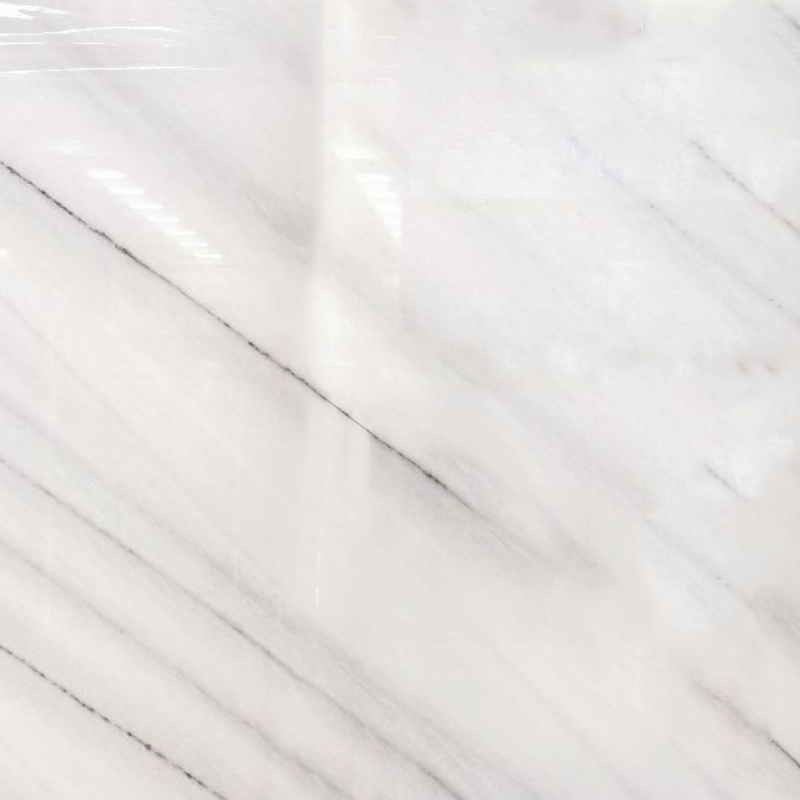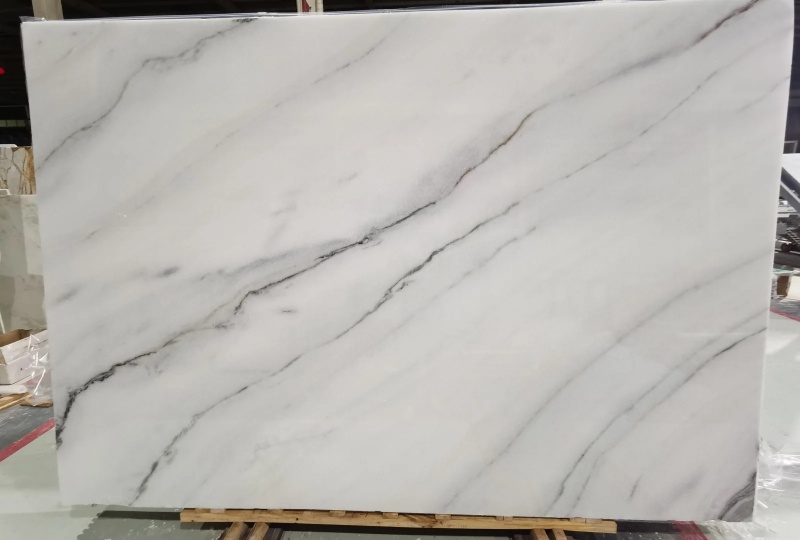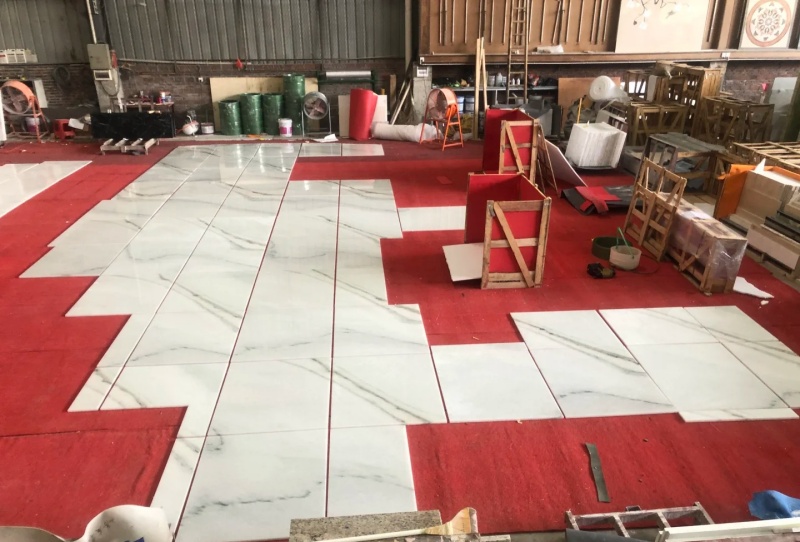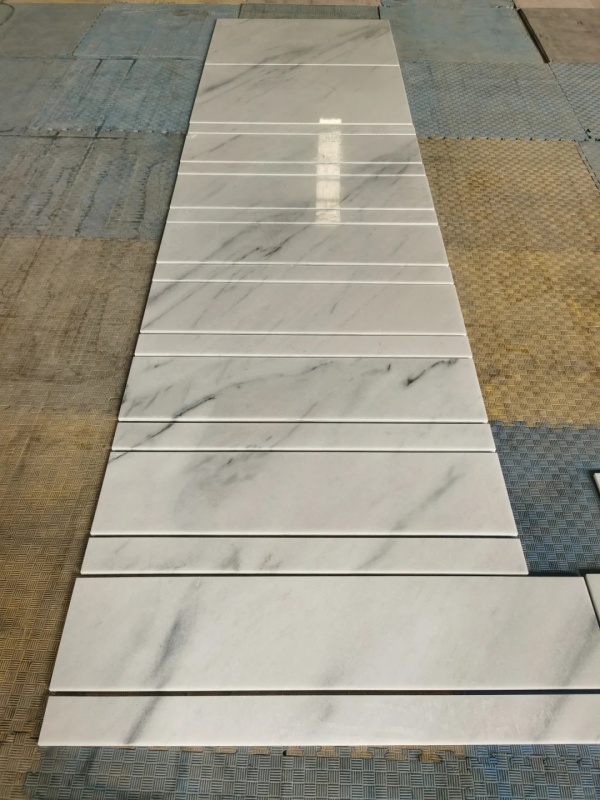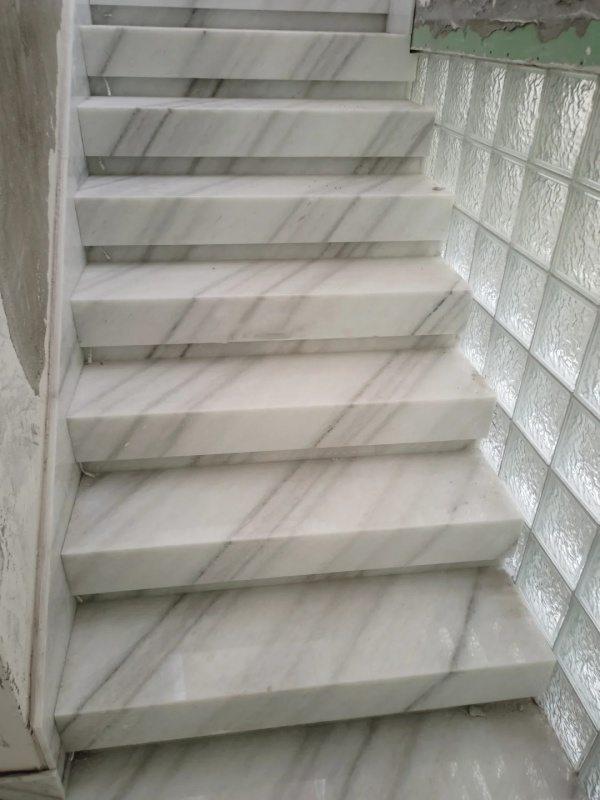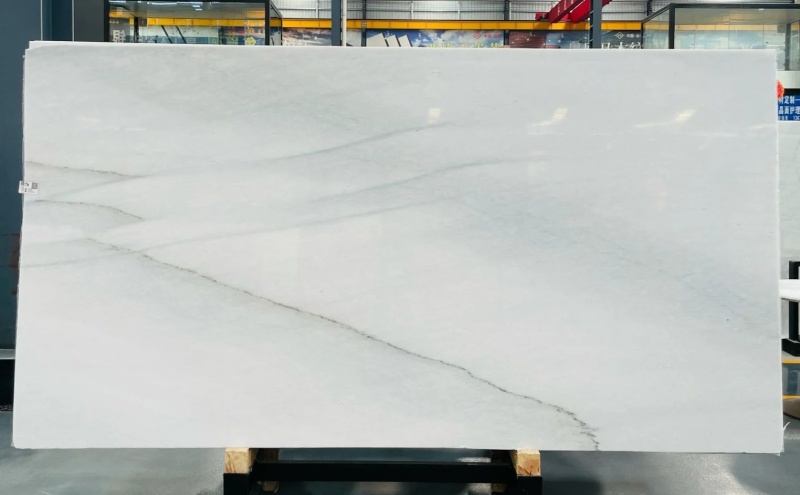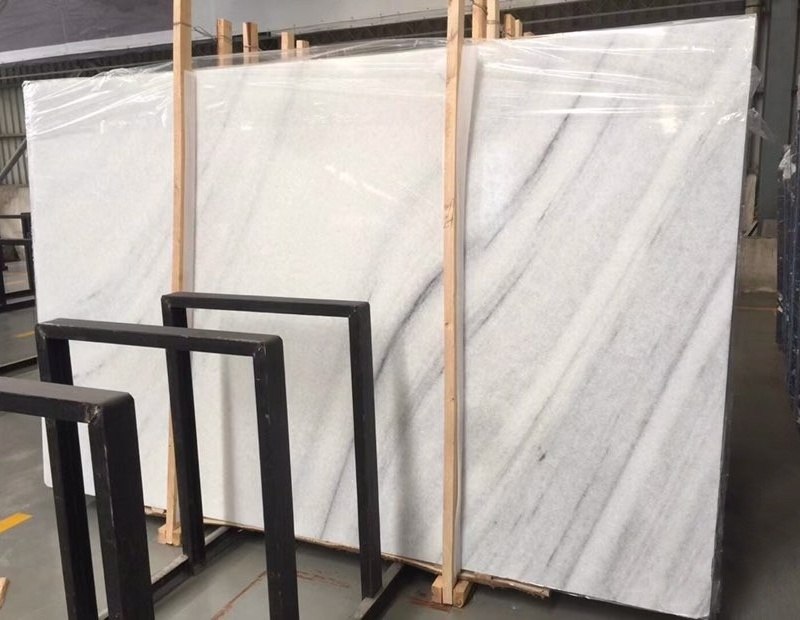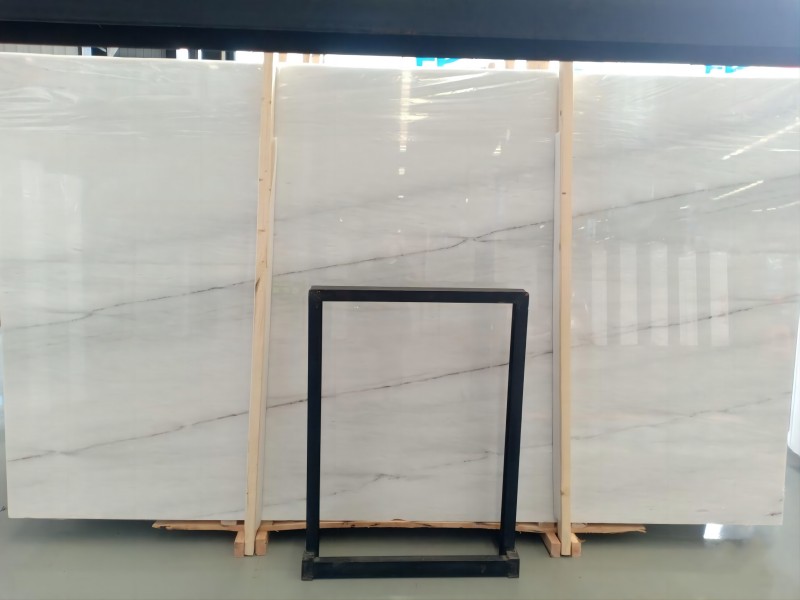Columbia White Marble
Columbia White Marble is a high-quality, pure white marble known for its elegant and sophisticated appearance. It is primarily used in luxury residential and commercial projects due to its striking beauty, clean white background, and refined aesthetics. Columbia White Marble is often chosen for high-end interior design, adding brightness, elegance, and timeless appeal to a variety of spaces.
Key Features of Columbia White Marble:
- Color and Appearance:
- Pure White Background: As the name suggests, Columbia White Marble features a predominantly white background. The clean, bright white color is highly sought after for creating airy, fresh, and sophisticated environments.
- Veining: Unlike some marbles with bold, contrasting veining, Columbia White Marble typically has subtle veining that may range from light gray to soft beige, with some slabs showcasing delicate linear or cloud-like veins. The veining is generally more understated, making the stone versatile and adaptable to a range of design styles.
- Minimalistic Elegance: The understated nature of the veining and the bright white base give Columbia White Marble a minimalist yet luxurious look. This makes it an excellent choice for modern and contemporary designs, as well as traditional interiors looking for a refined, timeless quality.
- Origin:
- Geographical Origin: Columbia White Marble is typically quarried in Colombia, though it can also be sourced from other locations with similar geological characteristics. Colombian marble is known for its high quality and consistency, making it a favored choice in both local and international markets.
- Durability:
- Strength: While marble is generally softer than granite or quartzite, Columbia White Marble is still relatively durable for indoor applications. However, like all marble, it is more susceptible to scratching, chipping, and staining than harder stones.
- Porosity: Marble is porous, so Columbia White Marble will require regular sealing to prevent staining, particularly in kitchens or bathrooms where it may come into contact with oils, acids, or liquids.
- Notable Fragility: Due to its softer composition, Columbia White Marble should be handled carefully during transportation and installation to avoid cracking or chipping, especially in thinner slabs.
- Applications:
- Countertops: Columbia White Marble is highly sought after for luxury kitchen countertops and bathroom vanities due to its aesthetic appeal and ability to brighten up spaces. Its smooth, polished finish creates a luxurious, reflective surface.
- Flooring: It is often used in high-end flooring applications, particularly in living rooms, hallways, and foyers, where its classic beauty can be showcased.
- Wall Cladding and Backsplashes: Its sleek, clean look makes it perfect for wall cladding and backsplashes, especially in kitchens and bathrooms. Columbia White Marble brings an air of refinement to these spaces.
- Sculptures and Decorative Pieces: Columbia White Marble is also used for sculptures, fireplace surrounds, and other architectural details, where its uniformity and color offer an elegant base for artistic expression.
- Versatility in Design:
- Timeless Aesthetic: The pure white color of Columbia White Marble makes it suitable for both modern and classic designs. It can fit seamlessly into various interior design styles, from minimalist and contemporary spaces to more traditional, opulent rooms.
- Pairing with Other Materials: The neutrality of Columbia White Marble allows it to pair beautifully with a variety of other materials, including wood, glass, metal, and even bold-colored accent pieces. It can act as a subtle backdrop to more vibrant materials or complement other natural stones like wood or black marble for contrast.
- Price:
- Premium Material: Columbia White Marble is considered a premium material, and its price can vary depending on the quality of the slab, size, and finish. As with most high-end marbles, it tends to be more expensive than common marble varieties due to its pristine white color and luxurious appearance.
- Installation Costs: The cost of installing Columbia White Marble can also be higher than for other stone types, especially for more complex cuts or intricate design work.
- Maintenance:
- Sealing: Like all marble, Columbia White Marble needs to be regularly sealed to maintain its surface and prevent staining. It is particularly prone to staining from oils, acidic substances (such as lemon juice or vinegar), and coffee or wine.
- Cleaning: To keep the marble looking its best, only pH-neutral cleaners should be used. Harsh chemical cleaners or abrasive pads can damage the surface, so gentle cleaning methods are recommended.
- Avoiding Scratches: Columbia White Marble can scratch more easily than harder stones like granite or quartzite, so care should be taken when using it in high-traffic areas or when placing sharp objects on its surface.
- Sustainability:
- Natural Stone: As a natural stone, Columbia White Marble is an environmentally friendly option compared to synthetic materials. However, marble extraction does have an environmental impact, particularly in terms of quarrying and transportation. Choosing marble from sustainable quarries or those that follow responsible mining practices can help mitigate some of these concerns.
Summary:
Columbia White Marble is a stunning and luxurious marble that stands out for its pure white background and subtle veining, making it a timeless choice for upscale interior design projects. Its versatility in both modern and classic settings, combined with its ability to brighten and elevate any space, makes it a favorite among designers for applications such as countertops, flooring, wall cladding, and decorative features. While it is relatively durable, it requires care and maintenance, including regular sealing to prevent staining and scratching.
For those seeking a sophisticated, elegant stone with a clean and minimalist aesthetic, Columbia White Marble offers an ideal option that combines timeless beauty with high-end luxury.
How does compare Columbia White Marble to other natural stones in terms of durability?
In terms of durability, Columbia White Marble is generally considered less durable than some other natural stones like granite, quartzite, and even some types of limestone. However, it is still a relatively strong and resilient material compared to many other building materials. Here’s a comparison of Columbia White Marble with some other popular natural stones, based on key durability factors:
1. Hardness
- Columbia White Marble: Marble, including Columbia White, ranks between 3 and 4 on the Mohs hardness scale, which means it is relatively soft compared to other natural stones. This makes it more prone to scratching from harder objects, such as knives, keys, or heavy objects with abrasive surfaces.
- Granite: Granite is much harder, with a Mohs hardness of 6 to 7, making it more scratch-resistant than marble. This is one of the main reasons granite is often preferred for high-traffic areas or kitchen countertops where the risk of scratching is higher.
- Quartzite: Quartzite is even harder than granite, ranking around 7 on the Mohs scale, which means it is extremely resistant to scratches and abrasions. It’s a very durable material, often favored for countertops that experience a lot of use.
- Limestone: Limestone is softer than marble, typically ranking around 3 on the Mohs scale, which makes it more susceptible to scratches and damage over time. It is generally used in less trafficked areas or where the patina from wear and tear is desired.
2. Porosity and Staining
- Columbia White Marble: Marble, including Columbia White, is highly porous. Without proper sealing, it can easily absorb liquids and oils, which can lead to staining. Columbia White Marble is especially vulnerable to stains from acidic substances like lemon juice, wine, or coffee. Regular sealing can reduce this risk, but the stone will still require more maintenance than non-porous materials like granite or quartz.
- Granite: Granite is much less porous than marble, making it more resistant to staining, especially when sealed properly. It is one of the best materials for kitchen countertops due to its resistance to most acids and liquids.
- Quartzite: Quartzite, like granite, is a harder and less porous stone, offering good resistance to staining and scratching. With proper sealing, it performs very well in high-traffic areas like kitchens.
- Limestone: Limestone is more porous than marble and more prone to staining and damage from acidic substances. Like marble, it needs to be sealed regularly to maintain its appearance.
3. Resistance to Impact and Chipping
- Columbia White Marble: Due to its softer nature, marble is more prone to chipping and cracking under impact compared to harder stones. While Columbia White Marble is generally strong enough for most indoor uses, it is more delicate than granite or quartzite and can be damaged by heavy impacts or dropped objects.
- Granite: Granite is much more resistant to chipping and cracking due to its hardness. It is the ideal choice for high-traffic areas, such as kitchen countertops and floors, where heavy items may be dropped.
- Quartzite: Quartzite is similarly tougher and more resistant to impact than marble. While it can still be chipped under extreme force, it holds up much better than marble.
- Limestone: Limestone is relatively soft and can be prone to chipping or cracking under impact, similar to marble but often to a greater extent due to its softness.
4. Heat Resistance
- Columbia White Marble: Marble is heat-resistant to a degree, but it can frost or crack if exposed to extreme temperature changes or direct, high heat (like from a hot pan or pot). For kitchen use, trivets or heat pads are essential to protect marble surfaces.
- Granite: Granite is more heat-resistant than marble and can withstand higher temperatures without cracking or discoloration. This makes it a better option for kitchen counters that will encounter hot cookware.
- Quartzite: Quartzite also has excellent heat resistance, often outperforming granite. Like granite, it can resist the heat from pots and pans without damage.
- Limestone: Limestone is more susceptible to heat damage than marble, especially if exposed to high temperatures over time.
5. Maintenance and Care
- Columbia White Marble: Columbia White Marble requires regular sealing (typically every 6-12 months) to maintain its appearance and prevent staining. Even with sealing, it needs to be cleaned with pH-neutral cleaners to avoid damaging the surface. The stone is also prone to scratching and needs careful attention when handling sharp objects or abrasive materials.
- Granite: Granite requires minimal maintenance. It still needs to be sealed, but less frequently than marble. It is more resistant to scratches and stains, making it easier to care for, particularly in kitchens.
- Quartzite: Like granite, quartzite requires less maintenance than marble. It needs to be sealed but is highly resistant to scratches, stains, and heat, making it one of the easiest natural stones to care for.
- Limestone: Limestone requires regular sealing and is prone to staining. It also needs careful cleaning to avoid etching from acidic substances. Due to its soft nature, it may need more maintenance than marble or granite.
6. Aesthetic Considerations
- Columbia White Marble: Columbia White Marble’s aesthetic is one of its biggest advantages. The stone’s bright, pure white color with subtle veining creates a clean and elegant look, ideal for modern, minimalist designs. However, due to its softness, it may show wear and scratches over time, especially in high-traffic areas.
- Granite: Granite offers a wide variety of colors and patterns, and its hardness allows it to maintain its aesthetic appeal longer. While it is not as visually striking as marble, its appearance remains largely unchanged over time.
- Quartzite: Quartzite is often more durable than marble and comes in a variety of unique colors and patterns. It can resemble marble in appearance but offers the durability of granite.
- Limestone: Limestone has a more natural, earthy appearance compared to marble, often with warm tones. It can give a rustic or Mediterranean feel but may wear more quickly due to its softness.
Summary of Durability Comparison:
| Property | Columbia White Marble | Granite | Quartzite | Limestone |
|---|---|---|---|---|
| Hardness (Mohs Scale) | 3-4 | 6-7 | 7 | 3 |
| Porosity | High | Low | Low | High |
| Scratch Resistance | Low | High | High | Low |
| Staining Resistance | Moderate to Low | High | High | Low |
| Impact Resistance | Low | High | High | Low |
| Heat Resistance | Moderate | High | High | Low |
| Maintenance | High | Low to Moderate | Low | High |
Conclusion:
Columbia White Marble is a beautiful and luxurious material, but in terms of durability, it lags behind stones like granite and quartzite, especially when it comes to scratch resistance, staining, and impact resistance. While it can be a great choice for high-end, low-traffic areas like bathrooms or living rooms, it may not be the best option for high-traffic kitchen countertops or surfaces exposed to heavy use. If you prefer a marble-like appearance but need better durability, quartzite is a good alternative. However, if the goal is to achieve a classic, timeless look with a slightly higher maintenance requirement, Columbia White Marble offers unmatched beauty.
What’s the Application of Columbia White Marble?
Columbia White Marble a range of high-end interior projects since its beauty and unusual tint are widely appreciated.
- Columbia White Marble countertop :Columbia White Marble is often used to create stunning kitchen countertops and bathroom vanity tops. Its striking white color and intricate veining add elegance and sophistication to these spaces.
2.Wall Cladding: As a wall covering,Columbia White Marble can create a focal point in any room. It is used in both residential and commercial settings to enhance the visual appeal of walls.
3.Flooring: While it is less commonly used for flooring compared to harder stones like granite ,Columbia White Marble still be used in areas with light foot traffic, such as bathrooms, entryways, and other interior spaces.
4.Feature Walls: The dramatic veining and color variations of Columbia White Marble make it ideal for creating accent walls or feature walls in living rooms, dining rooms, or even hotel lobbies.
5.Decorative Items: Smaller pieces of Columbia White Marble, such as tabletops, fireplace surrounds, and decorative objects, can be used to add a touch of luxury and sophistication to interior design.
6.Bathroom Applications: Besides vanity tops,Columbia White Marble can be used for shower walls, bathtub surrounds, and other bathroom surfaces to create a spa-like atmosphere.
7.Furniture: Custom furniture items like side tables, dining tables, and coffee tables. These works of art that are also useful elevate any room. Each furniture piece is distinctive and draws attention because of the distinctive patterns and colours of this Columbia White Marble
8.Art Installations: Designers and artists frequently work with Columbia White Marble to produce one-of-a-kind art installations. In galleries, public areas, and private collections, artistic works are made stand out by the depth and personality that the natural beauty of the stone provides.
What are the unique features of Columbia White Marble that make it appealing for interior design?
Columbia White Marble is a highly sought-after material in interior design due to its elegant and timeless qualities. Here are the unique features that make it particularly appealing:
1. Pure, Pristine White Color
- Clean, Fresh Aesthetic: Columbia White Marble is known for its bright, pure white background, which creates a fresh and airy feeling in any space. This clean aesthetic works particularly well in modern, minimalist, and contemporary design schemes.
- Reflects Light: The bright, reflective surface of Columbia White Marble helps enhance natural light within a space, making rooms feel larger and more open. This can be especially beneficial in smaller spaces or areas that don’t receive a lot of sunlight.
2. Subtle and Elegant Veining
- Understated Veins: The veins in Columbia White Marble are typically subtle and delicate, often appearing as soft, light gray, beige, or even gold patterns running through the stone. These soft veins add a sense of movement and texture to the material without overwhelming the design.
- Versatility: The gentle veining makes Columbia White Marble versatile and adaptable to many different design styles, from traditional to modern, allowing it to fit seamlessly into a wide range of spaces and complement other materials like wood, glass, or metal.
3. Timeless Appeal
- Classic Elegance: Columbia White Marble’s inherent elegance and sophistication have made it a timeless material in architecture and interior design. It has been used in luxury spaces for centuries and continues to evoke a sense of classic beauty and refinement.
- Luxurious Atmosphere: This marble is often associated with luxury and high-end design, making it an ideal choice for premium residential and commercial spaces such as high-end bathrooms, lobbies, or kitchens. It gives a sophisticated, upscale feel to any space.
4. Brightens Up Spaces
- Enhances Natural Light: The bright white color of Columbia White Marble makes it particularly effective at reflecting light, which can brighten up even dimly lit rooms. It works wonderfully in areas like kitchens, bathrooms, and living rooms where natural light is valued.
- Creates a Spacious Feel: By reflecting light and maintaining a clean, open look, Columbia White Marble helps create the illusion of space, making rooms appear larger and more expansive.
5. Adaptability in Various Applications
- Countertops and Backsplashes: Columbia White Marble’s subtle elegance makes it perfect for countertops and backsplashes in kitchens and bathrooms. Its timeless look enhances both classic and modern designs, while its clean surface can act as a neutral backdrop for more colorful or textured elements.
- Flooring and Wall Cladding: The uniform color and elegant veins make it suitable for high-end flooring and wall cladding, especially in luxury spaces such as entryways, living rooms, and bathrooms. The consistency in appearance also means it can be used in large formats, providing a smooth, continuous flow in the design.
- Sculptural and Artistic Uses: Columbia White Marble is often used for sculptural elements and decorative features, such as fireplaces, statues, or custom-designed furniture pieces, due to its ability to be shaped and polished into intricate forms.
6. Pairing with Other Materials
- Contrasting Accents: The neutral and soft tone of Columbia White Marble allows it to be paired with a wide range of materials. Whether paired with rich wood tones, metal accents, or bold-colored tiles, the marble provides a harmonious balance. The versatility of Columbia White Marble makes it easy to integrate into designs that combine different textures and materials.
- Complements Other Stones: This marble can be used alongside other stones such as black marble or granite for striking contrast, or even paired with materials like glass or metal for a more contemporary, industrial look.
7. Timeless and Modern Appeal
- Versatile for All Styles: While Columbia White Marble fits perfectly into traditional and classic interiors, its subtle veins and bright tone also allow it to seamlessly integrate into modern, minimalist, and even industrial styles. It offers a timeless appeal that remains relevant across different design trends.
- Elevates Modern Spaces: Even in a minimalist or contemporary setting, the luxury and depth of Columbia White Marble add a layer of sophistication and texture that elevates the overall aesthetic of the space.
8. Aesthetic and Practical Investment
- Long-Lasting Beauty: While marble requires proper care, Columbia White Marble is a durable material that, when maintained, can maintain its beauty for many years. Its ageless appeal ensures that it won’t easily go out of style and will continue to contribute to the aesthetic value of a space.
- Resale Value: The luxury nature of Columbia White Marble can also contribute to the resale value of a property, especially when used in kitchens and bathrooms, which are important selling points for high-end homes.
9. Sustainability Aspects
- Natural Stone: As a natural material, Columbia White Marble is environmentally friendly compared to synthetic alternatives. Although the quarrying process has an environmental impact, it is still a more sustainable choice than many engineered or synthetic materials. Choosing locally sourced marble can help reduce the carbon footprint associated with transportation.
Conclusion:
The unique features of Columbia White Marble—its pure white color, subtle veining, and timeless elegance—make it highly desirable in interior design. Whether used in luxury countertops, flooring, wall cladding, or sculptural elements, it adds a sense of refinement and sophistication to any space. Its ability to complement a wide variety of other materials and design styles makes it incredibly versatile, while its enduring beauty ensures it remains a staple in high-end interiors for years to come.
Factors affecting Columbia White Marble price?
The price of Columbia White Marble can vary significantly based on several factors, many of which are common to natural stones, while some are unique to marble and its specific origins. Here are the key factors that affect the price of Columbia White Marble:
1. Quality of the Stone
- Uniformity and Consistency: High-quality Columbia White Marble is prized for its uniform white background and subtle veining, with minimal imperfections or discoloration. The more consistent the appearance and fewer the variations in the slab, the higher the price. Slabs with large, irregular veins or color variations may be less expensive.
- Veining Patterns: The presence and pattern of veins can also impact price. Some buyers prefer more pronounced veins for a striking effect, while others opt for subtle veins for a more minimalist look. Marble with intricate or rare vein patterns can command a premium price.
- Polish and Finish: The finish applied to the marble (e.g., polished, honed, or brushed) can also affect its price. Polished Columbia White Marble has a higher gloss and refined surface that may cost more due to the additional labor and equipment required to achieve a smooth, shiny finish.
2. Size and Thickness of the Slab
- Slab Size: Larger slabs of Columbia White Marble are often more expensive due to the higher material costs involved in quarrying, transportation, and cutting. A larger slab provides more material to work with for flooring or countertops, which can be reflected in the price.
- Thickness: Thicker slabs generally cost more than thinner ones because they require more raw material and additional labor for cutting and polishing. Commercial projects may require specific thicknesses, influencing the price accordingly.
3. Source and Quarry Location
- Geographical Location: Columbia White Marble, like other stones, can vary in price depending on the quarry location. Marble sourced from well-known, established quarries with a reputation for high-quality stone (such as those in Colombia) tends to be more expensive than marble from lesser-known quarries.
- Transportation and Logistics: The cost of transporting marble from its source to the final destination also affects the price. If the marble is sourced from distant or international quarries (like Colombia), shipping costs can be high, especially for larger projects. Shipping, handling, and import duties contribute to the overall price.
4. Market Demand and Availability
- Rarity: If Columbia White Marble is less readily available or in high demand due to specific design trends or project requirements, the price can increase. Limited availability of a certain type or pattern of marble, or a scarcity of certain sizes or finishes, can cause prices to rise.
- Market Trends: The price of marble can fluctuate based on market trends and economic conditions. If white marble is particularly sought after in interior design or construction (due to a trend toward minimalist or luxury designs), prices may rise. Similarly, the global supply of natural stone may influence prices based on demand and availability.
5. Processing and Fabrication Costs
- Cutting and Shaping: Marble slabs must be cut, shaped, and polished to fit specific design requirements. The complexity of the cutting process, particularly if intricate designs or custom shapes are required, will increase the price. Custom fabrication for unique or intricate designs (such as beveled edges, specialized countertop shapes, or intricate inlays) adds to the cost.
- Edge Finishing: The type of edge finish (e.g., straight, beveled, ogee, bullnose) can impact the overall price due to the labor involved in cutting and finishing the edges.
6. Quality of Sealing and Maintenance
- Sealing and Maintenance: While sealing is usually an added cost (depending on the fabricator), it can also be a factor in determining the final price of the marble. High-quality sealing can protect the surface from staining and enhance its longevity, adding value to the final product. Some companies may offer sealing as part of the package, while others may charge extra, influencing the overall cost.
- Maintenance: Columbia White Marble requires regular maintenance to retain its appearance. If the marble comes with additional treatments, such as stain-resistant sealing or enhanced surface protection, it may be priced higher.
7. Finish Type
- Polished Finish: Marble with a high-gloss polished finish often carries a premium price. The polishing process requires more labor and specialized equipment, which adds to the overall cost.
- Honed Finish: A honed finish (matte or satin) is typically less expensive than a polished finish, as it requires less processing. However, it can be a popular choice for those seeking a more subdued, natural look.
- Textured or Brushed Finish: More labor-intensive textures, like a brushed or leathered finish, may increase the price due to the extra processing steps.
8. Customization and Special Orders
- Custom Cuts and Sizes: Special orders for custom-sized slabs or intricate design cuts can significantly increase the cost of Columbia White Marble. For example, if you’re ordering marble for a uniquely shaped countertop, vanity, or wall panel, the custom fabrication required will likely add to the cost.
- Limited Edition or Designer Collections: Some exclusive or designer collections of Columbia White Marble may carry a premium due to their rarity or specific, curated aesthetic qualities. If the marble has been selected by high-end designers or is part of a limited collection, the price may be higher.
9. Economic Factors
- Currency Exchange Rates: For marble imported from overseas (e.g., Colombia), fluctuations in currency exchange rates can affect the final price. A favorable exchange rate for the buyer’s currency could result in a lower price, while an unfavorable exchange rate could drive the cost up.
- Import Taxes and Duties: Import duties, taxes, and tariffs on natural stone can add additional costs, especially for materials imported internationally. These can significantly influence the final price, especially if the marble is shipped from a distant quarry.
10. Labor and Installation Costs
- Installation Complexity: The cost of installation plays a large role in the overall cost of Columbia White Marble. Depending on the complexity of the installation (e.g., large, seamless countertops, intricate cuts, or specialized patterns), the labor costs can be substantial.
- Skilled Labor: Marble installation requires specialized skills, particularly when dealing with high-end materials like Columbia White Marble. Expert craftsmanship for handling delicate slabs, cutting, and fitting can increase labor costs.
- Geographic Location of Installation: Installation costs can also vary by region, with higher labor rates in urban areas or locations where skilled stoneworkers are in demand.
11. Environmental and Ethical Considerations
- Sustainable Quarrying Practices: If the marble is sourced from a quarry that follows sustainable and ethical mining practices, it may be priced higher. The use of environmentally friendly techniques in extraction and transport can contribute to a premium price for the stone.
- Certifications: Marble with certifications for sustainability or ethical sourcing may come at a premium due to the additional costs associated with meeting specific environmental standards.
Summary of Price Influences:
| Factor | Impact on Price |
|---|---|
| Stone Quality & Consistency | High-quality, uniform stone with minimal imperfections is more expensive. |
| Size & Thickness | Larger or thicker slabs are more expensive. |
| Source & Quarry Location | Marble from renowned or distant quarries is pricier. |
| Market Demand & Availability | Higher demand or limited availability increases the price. |
| Processing & Fabrication Costs | Custom cuts, intricate designs, and finishes add to costs. |
| Sealing & Maintenance | Enhanced treatments for stain resistance increase the price. |
| Finish Type | Polished finishes are typically more expensive than honed or brushed. |
| Customization | Special orders or custom sizes raise the price. |
| Economic Factors | Currency fluctuations, taxes, and shipping affect price. |
| Labor & Installation Costs | Complex installation and skilled labor increase total costs. |
| Environmental & Ethical Practices | Sustainable practices may lead to higher prices. |
Ultimately, Columbia White Marble is a premium natural stone, and its price reflects the quality, craftsmanship, rarity, and sourcing involved in bringing it to market. For those willing to invest in its beauty and timeless appeal, the price is often justified by the elegance it brings to a space.
Why Opt For Xiamen Funshine Stone?
1.Our design consultation service at Funshine Stone gives our customers peace of mind, high-quality stone, and professional guidance. Our expertise lies in natural stone design tiles, and we offer comprehensive “top to bottom” consulting to realize your idea.
2.With a combined 30 years of project expertise, we have worked on a vast array of projects and established enduring relationships with numerous people.
3.With a huge assortment of natural and engineered stones, including marble, granite, bluestone, basalt, travertine, terrazzo, quartz, and more, Funshine Stone is pleased to provide one of the largest selections available. It is clear that our use of the best stone available is superior.







